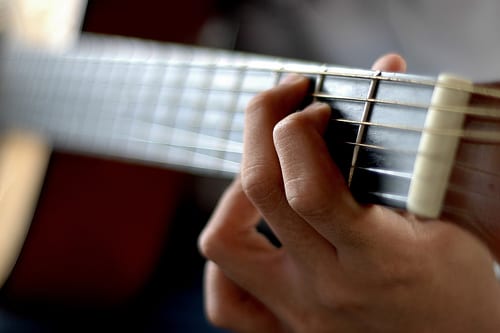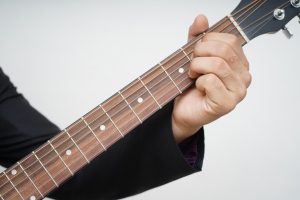 Are you interested in learning how to master guitar chord transitions? These tips will help to get you on the right track!
Are you interested in learning how to master guitar chord transitions? These tips will help to get you on the right track!
Beginning guitar lessons is anexciting thing – learning the notes, building your first chord, and of course, playing your first song. However, it’s not all sunshine and roses. Learning to play takes commitment, practice and the motivation to get over some common beginner hurdles. First, the painful process of building calluses can drive many to stop practicing. Second, there’s always that awkward stage of learning to seamlessly transition to different chords. You know the drill – practice makes perfect.
How Do You Improve Guitar Chord Transitions? 7 Simple Tips
Obviously, practice makes perfect when it comes to mastering challenging guitar chord transitions. Here are a few other ways you can start working on improving your guitar chord transitions.
- Think ahead. Always be one step ahead of yourself so you have the next chord in mind and can prepare.
- Keep your fingers close to the fretboard.
- Keep moving!
- Use a metronome to practice staying in time as you move (one of the most challenging parts).
- Use pivot fingers to help you change between frets.
- Keep your fingers down all at the same time.
- Practice until you get it perfect!
Here’s one more tip – watch videos of expert guitar players at work. This will help you get an idea of the rhythm and specific motions involved in effective electric and acoustic guitar chord transitions.
Take a look:
How Do You Master Guitar Chord Progressions?
The quick tips above should be enough to help you get started. But if you’re looking for even more information, here are some additional tips from Teachstreet.com to help with switching chords:
The quick tips above should be enough to help you get started. But if you’re looking for even more information, here are some additional tips from Teachstreet.com to help with switching chords.
1. Keep Your Fingers as Close to the Fretboard as Possible
When that pinkie and third finger start flying out in space it takes longer for them to come back down.
2. Build Your Chords from the Bottom String Up
For some reason, a lot of us get in the habit of building our chords from the top down. Like in an open C major chord, starting with the 2nd string, then 4th, then 5th. The problem with that is your pick is going to hit the bottom strings first, so get those notes placed first. That extra split second will give you a chance to get the last top bits of the chord in place. I know it seems like a negligible amount of time, but you’ll be surprised how it can improve your guitar playing.
3. Move the Farthest Finger First
When moving from one chord to the next, move the finger that has the farthest to go first. For instance, in moving from G major to C major in the open position, your first finger has to move all the way from the 5th string to the second. Lead with that finger and you’ll find that your other fingers naturally pull along behind to end up close to their intended frets as well.
4. Stay Relaxed
Let the natural movement of your hands help you get to the chord. Believe it or not, the guitar is actually designed very well to accommodate the natural movement of the human hand. When you use tip #3 and lead with the farthest finger, your other fingers will follow along behind it naturally and you can get them to settle in the right place. If you tighten up they won’t move as naturally, so stay loose.
5. Keep Your Right Hand Moving
The way your brain works has a lot to do with how your hands react. As a beginner, your brain is giving you permission to stop in between chords and rationalizes it as “we’ll get it eventually.” It’s normal and happens on a subconscious level. You can easily change that by setting up a dissonance in your brain. That means presenting your brain with a problem it needs to fix. Here’s the way it works: Your brain loves when your hands are moving together. So if you force your right hand to keep strumming, no matter what happens in your left, your brain will want to solve that dissonance by making your left hand move faster to keep up with your right. Exactly what we’re looking for.
6. Try Some Guitar Chord Transition Exercises
If you’re wondering how to practice guitar chord transitions, these guitar chord transition exercises can help you master the craft – and stay sharp.
Here is a helpful video with a breakdown of three helpful exercises that can help you fix the problems you’re having with guitar chord transitions:
3 Common Guitar Chord Transitions to Master
Here are some common guitar chord progressions and transitions you will need to master as a beginner guitarist.
Most will be in the key of C. These offer guitar players a great starting point when you’re writing new songs or improvising. Assign a number to each chord in the sequence.
The chords in the key of C progression include C, Dm, Em, F, G, Am (1, 2, 3, 4, 5, 6, respectively).
So the main progressions would include:
- 1-5-6-4
- 6-4-1-5
- 1-4-5-4
- 1-6-4-5
It might sound complicated, but once you get some practice and understand how to transition guitar chords in a way that makes sense to you, you’ll have these guitar transitions down pat in no time.
What is the Fastest Way to Transition Guitar Chords?
The best way to master guitar transitions between chords? Find a teacher who can help you master your technique in no time! You can sign up for online live lessons here.
Looking for a guitar teacher who can help you master chord transitions even faster? Search for a guitar teacher near you here.
You might also like…
– Learn to Play 20 Songs Using 5 Easy Guitar Chords
– 5 Common Mistakes of Beginner Guitarists
– How to Clean Your Guitar: 4 Easy Steps
Suzy S.


